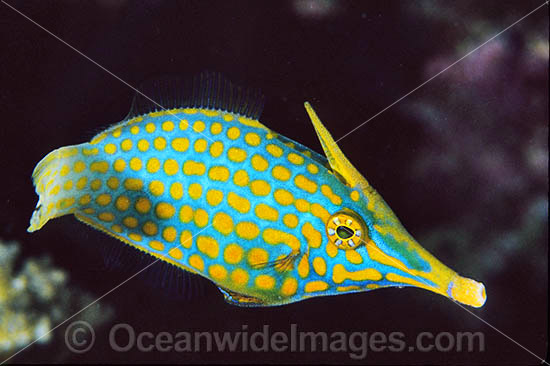Just for 'Zilla ...

As already mentioned, the answer is yes, at least for those that are defended by some suitable means. However, you have to bear in mind that in a coral reef habitat, some brightly coloured species are actually cryptic, coloured to match a background environmental feature such as a sea fan or hydroid, and only become conspicuous when moving away from that feature. Others are more conventionally cryptic: for example, here's
Atagema osseosa, a sponge feeding nudibranch that is colour matched to its food:
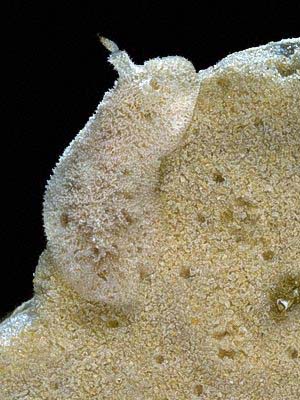
An even more spectacular example of blending with one's background is provided by this image:
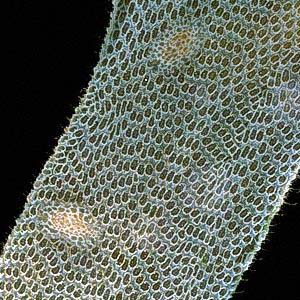
If you look
very closely, you can see two very small animals, which are members of one of the
Corambe species. The background upon which they are moving, consists of a colony of bryozoans (tentatively identified as a
Membranipora species), the bryozoans themselves growing upon Laminarian brown macroalgae.
An interesting example of mimicry is provided by this beast:
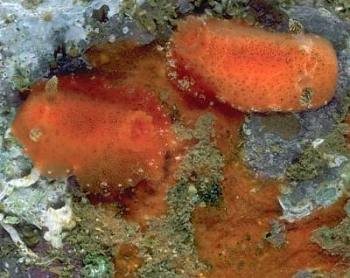
That is
Rostanga arbutus, a nudibranch that feeds upon orange-red coloured sponges known as
Clathria aceratoobtusa. The sponges themselves are bright red, because they produce distasteful toxins, and the nudibranch not only sequesters the toxins from the sponge, but mimics the appearance of the sponge it has just eaten.
Another nudibranch that acquires colouration from its food source is
Favorinus japonicus, a nudibranch that feeds upon the egg masses of other gastropods, usually members of the Genus
Aphysia. These egg masses can vary in colour, and the nudibranchs acquire the same colouration as their food in order to blend in with the background in question. Here's an image illustrating this:
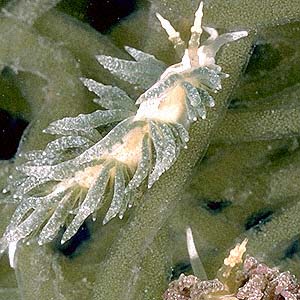
The green tentacular structures in the background are egg masses of an
Aphysia species. The
Favorinus nudibranch occupying most of the foreground in that image, has been feeding upon this egg mass for some time, and has acquired green colouration from the eggs. Appearing at bottom right is another
Favorinus nudibranch, that has been feeding upon pink egg masses previously, and is conspicuous against this new egg mass as a result of acquiring pink colouration from the previous food source.
Another species that mimics its food source is
Cuthonia kuiteri, which has cerata that mimic in appearance the polyps of the hydroid upon which it feeds, and thus remains camouflaged whilst feeding.
Superficially resembling the nudibranchs, but belonging to a different taxonomic clade (I once mistakenly thought it was a nudibranch until I checked the data) is
Elysia crispata, otherwise known as
Tridacha crispata. This is a gastropod mollusc (taxonomically, a Sacoglossan) that sequesters chloroplasts from seaweeds, and, remarkably, passes the chloroplasts undigested into its own body tissues, where the chloroplasts continue functioning, producing sugars for their new mollusc host! These chloroplasts are termed 'kleptoplasts', indicating that they are, in a sense, 'stolen' from the original seaweed host. Two hosts are known to be used by
Elysia crispata, namely
Halimeda incrassata and
Penicillus capitatus. Other chloroplast sequestering species include this one:
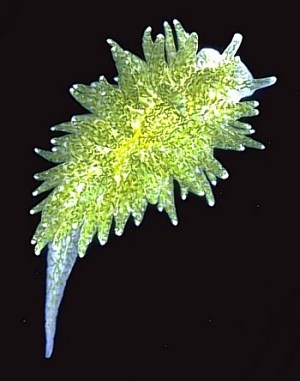
That is another Sacoglossan,
Placidia cf. dendritica.
By contrast, all nudibranchs are carnivorous, feeding upon a variety of animal organisms, but even amongst these, there are species containing plant cells. If they are carnivorous, how do they obtain these plant cells? Simple. Many colonial Cnidarians, principally reef building corals, contain within their body tissues symbiotic algae known as Zooxanthellae - indeed, for reef buiding corals, the relationship is obligate, and without the Zooxanthellae, the coral polyps will die. Several Aeolid nudibranchs feed upon reef building corals, and when they do so, they sequester the Zooxanthellae from the coral polyps in the gut, pass the algal cells undigested into their cerata, and 'farm' the algae within their bodies, where the algae once again provide nutrients for the new host via photosynthesis. A typical species that feeds in this manner is this one,
Pteraeolidia ianthina, the Zooxanthellae giving the nudibranch a brown colour when distributed to the cerata:

A list of scientific papers covering chloroplast sequestering, principally in Sacoglossan gastropods, can be found
here.
Then we have, apart from nudibranchs that sequester cnidoblasts for defence, a different group of nudibranchs that manufacture toxins intrinsically, as part of their metabolic processes.
Phyllidiella pustulosa is an example of such a species (the entire Genus produces a range of nasty toxins, mainly sesquiterpene isocyanides - a relevant paper can be found
here), and numerous creatures mimic these nudibranchs, including some other nudibranchs, a turbellarian flatworm, and even a Holothurian (sea cucumber). Another image coming up:
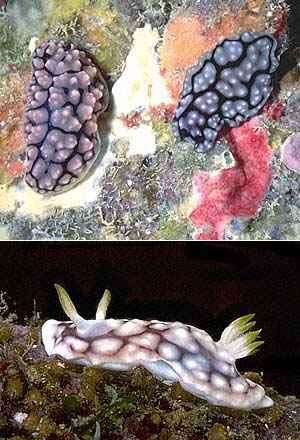
On the left of that image is
Phyllidiella pustulosa itself, and on the right is a Turbellarian flatworm,
Pseudoceris imitatus, which is a near-perfect Batesian mimic. Likewise, a mimic of the related Genus
Phyllidia is provided by
Aldisia erwinkoehleri, seen below:

Compare it with
Phyllidia alyta below:

Just when you thought biology couldn't get more complicated!

And just when 'Zilla thought he'd escape one of my long posts ...





